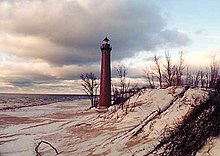Little Sable Point Light

Listed in National Register of Historic Places
|
|
| Location | Ten miles south of Pentwater, Michigan on Lake Michigan, Little Sable Point, Golden Township, Michigan |
|---|---|
| Coordinates | 43°39′6″N 86°32′20″W / 43.65167°N 86.53889°WCoordinates: 43°39′6″N 86°32′20″W / 43.65167°N 86.53889°W |
| Year first constructed | 1874 |
| Year first lit | 1874 |
| Automated | 1955 |
| Foundation | 109 wooden piles, driven into sand |
| Construction | Rust brick, Italianate bracketing |
| Tower shape | Frustum of a cone |
| Markings / pattern | Red brick, natural (orig. white), black trim and lantern |
| Height | 107 feet (33 m) |
| Focal height | Focal plane - 108 feet (33 m) |
| Original lens | Third-Order Fresnel lens |
| Current lens | Third-Order Fresnel lens |
| Intensity | 40,000 candlepower |
| Range | 15 nautical miles; 27 kilometres (17 mi) |
| Characteristic | Flashing white, 1 flash every 6 sec. |
| ARLHS number | USA-443 |
| USCG number |
7-18645 |
|
Little Sable Point Light Station (U.S. Coast Guard Light Station/Great Lakes)
|
|
| Area | 1 acre (0.40 ha) |
| Architect | Col. Orlando M. Poe |
| Architectural style | Italianate bracketing |
| MPS | U.S. Coast Guard Lighthouses and Light Stations on the Great Lakes TR |
| NRHP Reference # | 84001827 |
| Added to NRHP | July 19, 1984 |
7-18645
The Little Sable Point Light is a lighthouse located south of Pentwater in the lower peninsula of the U.S. state of Michigan. It is in the southwest corner of Golden Township, just south of Silver Lake State Park.
The lighthouse was designed by Col. Orlando M. Poe and has been described as "A classic Poe tower." The design used 109 1-foot-diameter wood pilings to be driven into the sand, capped by 12 feet of stone as a stout base for the brick tower. The walls of the tower are 5 feet (1.5 m) thick at the base and 2 feet (0.61 m) at its zenith.
Following the loss of the Schooner Pride in 1866, public outcries for a light at this locale were finally heard and heeded. Congress approved funding in 1871, but construction was delayed until 1874 due to lack of roads to the site.
The station was originally named "Petite Pointe Au Sable Lighthouse", which is the name used on most official records; officially, however, the name was changed in 1910. Although commonly called "Little Sable Point Light", it is listed by the National Park Service as "Little Point Sable Light".
The lantern room has eight fixed panels in its lower section, and the upper has ten rotating panels.
In 1954, the Lighthouse keeper's dwelling was destroyed by the Coast Guard when electricity reached the site and the light was automated. "Evidence of the connection between the dwelling and tower are obvious to the visitor."
Prior to 1900, the brick was left in its natural color and state, as it was unusually hard and held up well to the elements. (Unlike its sister, Big Sable Point Light, which was made from Cream City Brick, and had to be encased in steel boilerplate to retard the deterioration.) Having it in natural tones, however, was a boon to the Lighthouse keeper, who did not have to apply a yearly coat of whitewash. In 1900 the light was painted white for the first time, to assuage the complaints of mariners who said the brick was difficult to see. It remained that color until 1975, when it was sand blasted, and returned to its natural color. The lantern is capped by a copper roof.
...
Wikipedia

